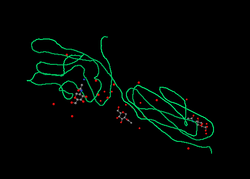CD2 (cluster of differentiation 2) is a cell adhesion molecule found on the surface of T cells and natural killer (NK) cells. It has also been called T-cell surface antigen T11/Leu-5, LFA-2,[5] LFA-3 receptor, erythrocyte receptor and rosette receptor.[6]
Function
It interacts with other adhesion molecules, such as lymphocyte function-associated antigen-3 (LFA-3/CD58) in humans, or CD48 in rodents, which are expressed on the surfaces of other cells.[7]
In addition to its adhesive properties, CD2 also acts as a co-stimulatory molecule on T and NK cells.[8]
Diagnostic relevance
CD2 is a specific marker for T cells and NK cells, and can therefore be used in immunohistochemistry to identify the presence of such cells in tissue sections. The great majority of T cell lymphomas and leukaemias also express CD2, making it possible to use the presence of the antigen to distinguish these conditions from B cell neoplasms.[9]
Classification
Due to its structural characteristics, CD2 is a member of the immunoglobulin superfamily; it possesses two immunoglobulin-like domains in its extracellular portion.[8]
Interactions
CD2 has been shown to interact with CD2BP2,[10] Lck[11] and PSTPIP1.[12]
References
Further reading
External links
- CD2+Antigen at the U.S. National Library of Medicine Medical Subject Headings (MeSH)
- Mouse CD Antigen Chart
- Human CD Antigen Chart
- Human CD2 genome location and CD2 gene details page in the UCSC Genome Browser.





